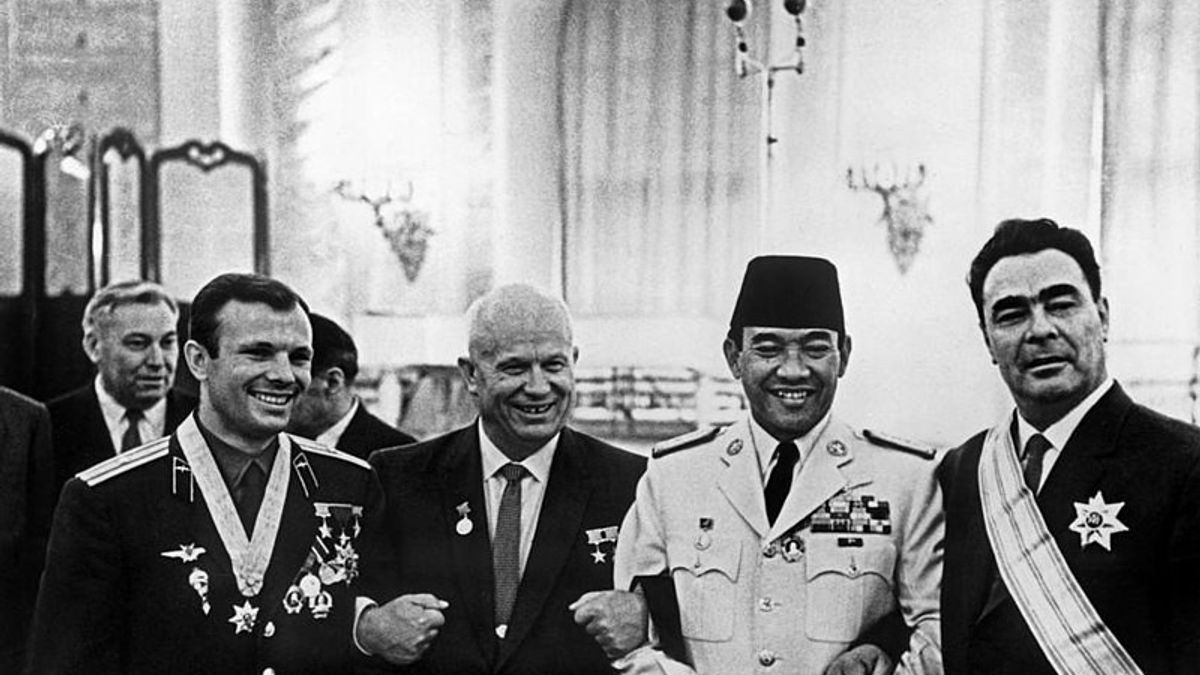JAKARTA – Today's history, April 12, 1961, records the event of Yuri Gagarin as the first person in the world to explore outer space. Yuri Alekseyevich Gagarin, a cosmonaut from the Soviet Union, heads into space in the Vostok 1 spacecraft which orbits the earth at an altitude of 360 km for 1 hour 48 minutes.
Gagarin is the son of a carpenter from Klushino, a village in the Smolensk administrative region located 360 km southeast of Moscow. He was born on March 9, 1934. At the age of 16 Gagarin moved to Moscow to work in the steel industry, while continuing his education.
His interest in aviation led Gagarin to enroll in the USSR Air Force Cadet Education. Graduating in 1957, Gagarin was placed in a squadron of Soviet fighter jets.
In 1960 Gagarin and another pilot named Gherman Titov passed the cosmonaut candidate screen in the Soviet space program. Gagarin and Titov eliminated the 19 candidates called in the program.

The important day that is recorded in history today has arrived. On April 12, 1961 at the age of 27, Gagarin was launched from the Soviet space base at Baikonur, in what is now the Republic of Kazakhstan. The Vostok 1 probe was launched into space on the Vostok-K rocket. After Gagarin, this rocket successfully launched five other Soviet manned space probe missions until 1964.
“Do I enjoy going to space? Of course. In every time and age, it is a joy for people to participate in every new discovery. I dedicate this first space flight to the communists, a society like us Russians are already on it, and I'm sure everyone on earth will be on it too," Gagarin said in his message before starting the flight, as quoted from the page. Roscosmos, the state company in charge of Russia's current space projects.
The Vostok-K rocket, carrying Vostok 1 and Gagarin on board, launched at 06.07 local time. It takes 10 minutes for Vostok-K to reach orbit at an altitude of 360 km.
Vostok Track 1Gagarin did not pilot the Vostok 1 manually, as all control was done automatically from the main base at Baikonur. It revolves around the earth to the east, in line with the rotation of the earth.
From launch at Baikonur, Vostok 1 headed for Siberia, the Kamchatka Peninsula, then diagonally across the Pacific Ocean. The vehicle did not cross the Americas, but circled to the south through Argentina.

Then up again, diagonally across Africa. A second tier rocket fires over Angola to cross Africa to Egypt. After reaching Egypt, Vostok 1 and Gagarin began preparing to return to earth. Vostok 1 landed in Engels, Saratov administrative region by parachute plunge at 08.05 local time.
Soviet propagandaGagarin's success in the Vostok 1 space project then became a tool of Soviet propaganda, the superiority of the socialist system over the capitalist. A massive parade was held in Moscow to celebrate Gagarin's successful space flight. The parade reportedly surpassed Russia's victory over Germany in World War II.
The Soviets at that time outperformed the United States, which was preparing a space program under the name Project Mercury. This project was only realized on February 20, 1962, when astronaut John Glenn managed to enter Earth orbit with the Mercury-Atlas 6 spacecraft.
Meanwhile, the Soviets after Gagarin's success, again successfully launched the Vostok 2 spacecraft with cosmonaut Titov on August 6, 1961. Titov, who became Gagarin's reserve in the Vostok 1 project, was in space for 25 hours and made 17 rounds of the earth.

April 12 was later commemorated as USSR Cosmonautics Day. The commemoration is eternal even though the Soviet Union has disappeared from the face of the earth, because the Russian Federative Republic still commemorates it as Cosmonautics Day. Even the United Nations later inaugurated April 12 as the International Day of Human Aviation into Space.
Gagarin died in a fighter plane crash he was piloting on 27 March 1968. He was 34 years old when the MiG-15 he was piloting crashed in Novosyolovo, killing him. Yuri Gagarin's exploration as the first man in outer space is in history today, April 12, 1961.
The English, Chinese, Japanese, Arabic, and French versions are automatically generated by the AI. So there may still be inaccuracies in translating, please always see Indonesian as our main language. (system supported by DigitalSiber.id)











